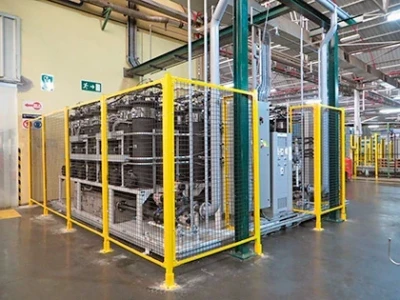How to Improve Transformer Protection

Using symmetrical components for fault discrimination in differential protection
BY IMRAN RIZVI, ABB Inc.
Classical differential protection schemes are subject to ghost differential currents due to current transformer (CT) saturation and magnetization currents. Several methods are used to counter the impact of these unwanted differential currents. Electricity Today Magazine and ABB will focus on how to improve transformer protection by using the symmetrical component techniques to stabilize differential protection schemes without sacrificing the speed and sensitivity of the protection. Negative sequence quantities are inherently present in any power system disturbance. Even in the case of a three-phase symmetrical fault, negative sequence currents are present during the first few cycles of the fault as a result of the direct current (DC) component.
By accurately measuring the magnitudes and relative phase angles of the negative sequence, currents leaving and entering into the differential zone can provide a very reliable indication of whether the fault is inside or outside of the protection zone. In addition, it can supplement the traditional restrained differential protection to achieve high levels of speed with very high sensitivity for high impedance faults. In transformer protection, turn-to-turn faults at the neutral points are typically difficult to detect. By using negative sequence quantities, these faults can be detected reliably.
DIFFERENTIAL PROTECTION
Differential protection has been around for many decades. It’s a simple and selective method of protecting transformers, busbars, and generators. Figure 1 shows a typical differential protection scheme as applied to a power transformer with numerical relays. It is conventional that the star points of both the CTs should be towards the power transformer (towards the protected object).
The boundaries of the differential zone of protection are determined by the location of these CTs. In normal conditions when there is no fault in the transformer zone, the current going into the protection zone will be equal (theoretically at least) to the current going out of the protection zone. But if there is a difference between these two currents more than a set value, then it’s an indication of a fault in the protected zone. However, due to the turn ratio and vector group of the transformer, we cannot just take these two currents without first compensating them. This compensation was done by auxiliary CTs before the advent of numerical relays. Now, these compensations are performed software wise in the algorithm of the relays. Utilities just need to properly set the relay based on the actual situation at the site.
The relay will compensate for the magnitude of the current difference as per the turn ratio of the transformer. It will also compensate for the phase angle shift caused due to the vector group of the transformer by a multiple of 30 degrees. The use of numerical relays also allows us to use both (all primary CTs in the case of three winding transformers) primary CTs to be connected in Y fashion and still eliminate the zero sequence currents by putting the right setting in the relay. The modern numerical relays can also compensate for the on-load tap changer (OLTC) by recognizing the tap position via the binary-coded-decimal (BCD) input or milliampere (mA) input and then making adjustments in differential current values.









